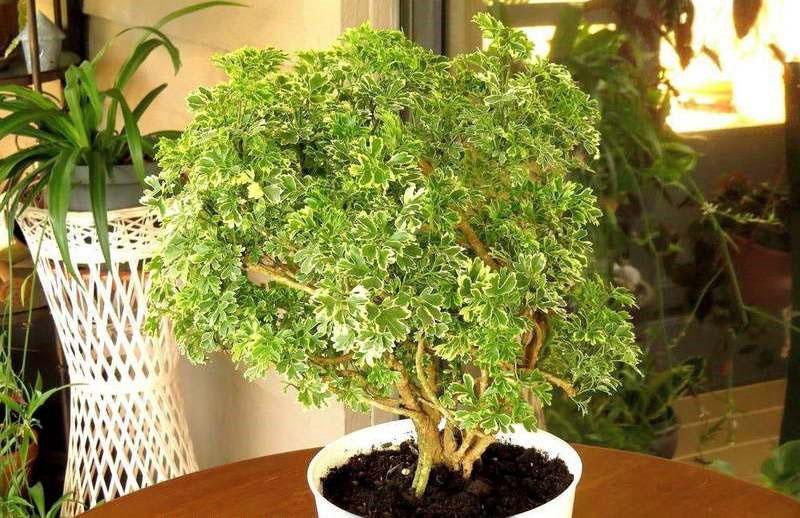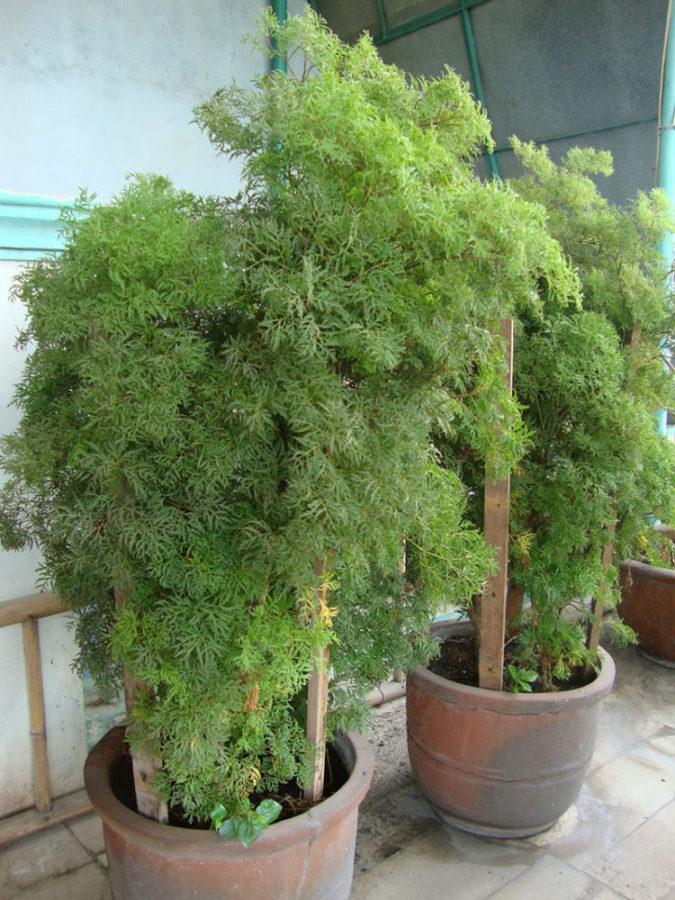What is the peculiarity of caring for a capricious policeman at home
 The decorative properties of a houseplant allow you to create original compositions with a tree. Nevertheless, the poliscias, whose home care requires special efforts, is quite "finicky" when growing. Despite this, the florist can please his “demanding ward”. It is only necessary to understand that the homeland of this representative of the Araliev family is the tropical climate of Southeast Asia. At the same time, its closest "relatives" include numerous varieties ivy and fatsia.
The decorative properties of a houseplant allow you to create original compositions with a tree. Nevertheless, the poliscias, whose home care requires special efforts, is quite "finicky" when growing. Despite this, the florist can please his “demanding ward”. It is only necessary to understand that the homeland of this representative of the Araliev family is the tropical climate of Southeast Asia. At the same time, its closest "relatives" include numerous varieties ivy and fatsia.
Polisias: home care

The importance of proper lighting
 There are more than 100 species of indoor plants in this family, which make up two groups: green-leaved and variegated. The first category requires diffused lighting, while the second requires bright light. However, in direct sunlight, burns appear on the foliage. In summer and winter, the length of daylight hours should be the same. For this reason, phytolamps are additionally used.
There are more than 100 species of indoor plants in this family, which make up two groups: green-leaved and variegated. The first category requires diffused lighting, while the second requires bright light. However, in direct sunlight, burns appear on the foliage. In summer and winter, the length of daylight hours should be the same. For this reason, phytolamps are additionally used.  Caring for a police officer at home involves choosing the right place. The most optimal option for an ornamental plant will be windows facing east or west. In addition, you cannot constantly turn / twirl the pot in different directions, otherwise the flower will drop the foliage
Caring for a police officer at home involves choosing the right place. The most optimal option for an ornamental plant will be windows facing east or west. In addition, you cannot constantly turn / twirl the pot in different directions, otherwise the flower will drop the foliage
The florist should take into account that in indoor conditions this representative of tropical latitudes will never bloom. It is used only as an ornamental deciduous plant.
Temperature regime
 Moderation is the main characteristic when growing Polyscias. Therefore, in the warm season (growing season), the optimum temperature is maintained at + 20 ... + 22˚С, and in the winter - + 17 ... + 19˚С. Critical for an indoor flower will be + 25˚С. Dry air coming from the battery will also be especially dangerous for him. In this case, a thick sheet of plexiglass or film is used.
Moderation is the main characteristic when growing Polyscias. Therefore, in the warm season (growing season), the optimum temperature is maintained at + 20 ... + 22˚С, and in the winter - + 17 ... + 19˚С. Critical for an indoor flower will be + 25˚С. Dry air coming from the battery will also be especially dangerous for him. In this case, a thick sheet of plexiglass or film is used.
Among other things, you must:
- regularly ventilate the room, avoiding the formation of drafts;
- maintain high air humidity (70-80%) using pallets with wet expanded clay, moss sphagun and pebbles;
- sometimes take the flowerpot out onto the balcony or street.

The dormant period in a tropical culture is not pronounced. However, it is in winter that the ornamental tree grows more slowly than usual.
 The well-being of an indoor flower largely depends on the correct composition of the soil. The substrate is chosen light and airy, capable of passing moisture. The acid reaction should be neutral. An excellent solution would be a universal soil mixture with the addition of perlite or broken brick.
The well-being of an indoor flower largely depends on the correct composition of the soil. The substrate is chosen light and airy, capable of passing moisture. The acid reaction should be neutral. An excellent solution would be a universal soil mixture with the addition of perlite or broken brick.
Water procedures
 Humidity is the most important factor in the life of a policeman. These conditions will be close to his native tropics.
Humidity is the most important factor in the life of a policeman. These conditions will be close to his native tropics.
The following procedures will provide such an environment.:
- daily spraying (1-2 times in the morning, so that moisture is absorbed by night);
- periodic shower (it is advisable to cover the ground with a film);
- moistening the pan with a drainage mixture.
Excessive moisture is detrimental to the flower. You should be extremely careful when the temperature drops, drafts or when using large containers.
 Abundant watering of the flowerpot is carried out when the top layer dries at the depth of the phalanx of the index finger. For this, settled water is used, the temperature of which varies from +25 to 28˚С. In addition, mineral fertilizers are applied every 2 weeks, as well as complex preparations for ornamental crops. In winter, the number of water procedures is significantly reduced.
Abundant watering of the flowerpot is carried out when the top layer dries at the depth of the phalanx of the index finger. For this, settled water is used, the temperature of which varies from +25 to 28˚С. In addition, mineral fertilizers are applied every 2 weeks, as well as complex preparations for ornamental crops. In winter, the number of water procedures is significantly reduced.
Irrigation technology. The earth clod is evenly wetted. The water jet is directed exclusively to the edges of the pot.
Reproduction is a complex and time-consuming process
 The problem in this case lies in the long process of rooting of representatives of the genus Polyscias. However, this factor does not stop florists. First of all, cuttings are harvested. In the spring, a stalk with 3 internodes is cut from the mother plant. The cut is processed by phytohormone.
The problem in this case lies in the long process of rooting of representatives of the genus Polyscias. However, this factor does not stop florists. First of all, cuttings are harvested. In the spring, a stalk with 3 internodes is cut from the mother plant. The cut is processed by phytohormone.
The sprout will take root if it:
- transfer to clean peat or with the addition of sand;
- cover with foil;
- maintain the temperature up to + 25˚С;
- constantly moisturize (75%);
- periodically ventilate the container.
In many cases, even with painstaking care, the result may not be successful.
 Some people try the method of dividing the rhizome. When transplanting a shrub, the roots are divided into small fragments (up to 3 cm in length). The resulting segments are placed in a container with wet sand. The roots are located vertically in the ground. However, the tip edge is left flush with the soil. The pot is not covered.
Some people try the method of dividing the rhizome. When transplanting a shrub, the roots are divided into small fragments (up to 3 cm in length). The resulting segments are placed in a container with wet sand. The roots are located vertically in the ground. However, the tip edge is left flush with the soil. The pot is not covered.
Transfer
 The event is planned for the next year after the young seedling is planted. Adult specimens need to be replaced every 2-3 years. The pot is selected taking into account the size and growth of the tree. So, a large capacity is not suitable for too small and vice versa. Instead of a universal soil substrate, self-prepared soil is often used.
The event is planned for the next year after the young seedling is planted. Adult specimens need to be replaced every 2-3 years. The pot is selected taking into account the size and growth of the tree. So, a large capacity is not suitable for too small and vice versa. Instead of a universal soil substrate, self-prepared soil is often used.
To do this, mix in equal proportions:
- turf (possible with admixtures of clay);
- deciduous land;
- peat;
- humus;
- sand.
 Holes must be made at the bottom of the pot. The drainage is filled up in the form of a 3-cm layer of expanded clay. These features of cultivation will help create optimal conditions for a "capricious" plant.
Holes must be made at the bottom of the pot. The drainage is filled up in the form of a 3-cm layer of expanded clay. These features of cultivation will help create optimal conditions for a "capricious" plant.
Vermiculite is not introduced into such soil mixtures. Under the influence of moisture, the material completely decomposes within 6 months.
A great variety of species and varieties of polisias
 Collecting flower growers strive to get hold of specimens with unique decorative properties. There are up to 80-100 species in total. Variegated varieties are especially popular. Indoor plants with a rich green color also found their place in the interior. The decisive factor was the unusual shape of the carved foliage.
Collecting flower growers strive to get hold of specimens with unique decorative properties. There are up to 80-100 species in total. Variegated varieties are especially popular. Indoor plants with a rich green color also found their place in the interior. The decisive factor was the unusual shape of the carved foliage.
Folisifolia is a competitor to ferns
 As it grows, the evergreen shrub grows both in height and in width. Thanks to the original lobed leaves, the plant was named Poliscias Fern-leaved. Beautiful openwork branches sometimes reach 35-50 cm in length. The tight fit of pinnately dissected leafy plates to each other gives the flower a special pomp.
As it grows, the evergreen shrub grows both in height and in width. Thanks to the original lobed leaves, the plant was named Poliscias Fern-leaved. Beautiful openwork branches sometimes reach 35-50 cm in length. The tight fit of pinnately dissected leafy plates to each other gives the flower a special pomp.
The root system is characterized by intensive growth. Therefore, for the Polistias Folisifolia (Filisifolia) you will need a large pot with good drainage.
Balfura (Balfuriana) - luxury of kings
 A short, compact shrub known for its luxurious foliage. The rounded plates are about 7 cm in diameter. Closer to the edge, they are dissected into 3 large lobes, which resemble bird feathers. A distinctive feature of the Poliscias Balfuriana is the presence of silvery veins or borders on the foliage.In other interpretations, light specks with a slight overflow often appear on the plates.
A short, compact shrub known for its luxurious foliage. The rounded plates are about 7 cm in diameter. Closer to the edge, they are dissected into 3 large lobes, which resemble bird feathers. A distinctive feature of the Poliscias Balfuriana is the presence of silvery veins or borders on the foliage.In other interpretations, light specks with a slight overflow often appear on the plates.
Usually, flower growers prefer to grow:
- Butterfly;
- Pennockii (very large bluish-green leaves);
- Variegata.
 Over time, shoots of the culture acquire a greenish tint with a slight smoky tint. The petioles are not particularly branchy. A shrub-type tree reaches a height of 150 cm. Poliscias Balfouriana (from the Latin name Polyscias balfouriana) is not as whimsical as many of his "relatives". The attractiveness of the variety lies in the unusually voluminous crown and decorative coloring of the leaves.
Over time, shoots of the culture acquire a greenish tint with a slight smoky tint. The petioles are not particularly branchy. A shrub-type tree reaches a height of 150 cm. Poliscias Balfouriana (from the Latin name Polyscias balfouriana) is not as whimsical as many of his "relatives". The attractiveness of the variety lies in the unusually voluminous crown and decorative coloring of the leaves.
If the variegated variety loses its color, then the plant has insufficient lighting.
Helmet - a spectacular guest of the winter garden
 The uniqueness of this variety lies in the highly curved and unusually thick trunk. At the same time, Poliscias Shlemovidny (Scutellaria) is distinguished by rather straight branches that grow exclusively upward.
The uniqueness of this variety lies in the highly curved and unusually thick trunk. At the same time, Poliscias Shlemovidny (Scutellaria) is distinguished by rather straight branches that grow exclusively upward.
Indoor culture leaves:
- wide and rounded;
- three-plate (separation is manifested in adulthood);
- green color with a slight purple tint (sometimes with a light border).
 Poliscias Fabian helmet-shaped (variety with a dark purple color) grows very quickly and can stretch up to 2 m. To restrain its violent development, erect shoots are regularly cut off. In some cases, a shrub "with a slight movement of the hand" turns into a miniature tree - bonsai.
Poliscias Fabian helmet-shaped (variety with a dark purple color) grows very quickly and can stretch up to 2 m. To restrain its violent development, erect shoots are regularly cut off. In some cases, a shrub "with a slight movement of the hand" turns into a miniature tree - bonsai.
The appearance of light spots on dark green foliage indicates sunburn. In this regard, the flowerpot is transferred to a shaded place.
Shrub - a favorite of florists
 Leadership in decorativeness is rightfully assigned to this variety. Poliscias Shrub (Fruticosa) has feathery finely dissected leaves with a toothed-serrate edge. The openwork shrub fascinates with its luxurious appearance.
Leadership in decorativeness is rightfully assigned to this variety. Poliscias Shrub (Fruticosa) has feathery finely dissected leaves with a toothed-serrate edge. The openwork shrub fascinates with its luxurious appearance.
The best varieties of this group include:
- Filigree (maximally dissected foliage);
- Multifida (with fine villi);
- Snow Flake (with white border).
 Remarkably, the shape of the leaves of the shrub species can vary from round to lanceolate. In this case, the type of section is individual in each case.
Remarkably, the shape of the leaves of the shrub species can vary from round to lanceolate. In this case, the type of section is individual in each case.
The plant slows down growth not only at rest, but also when there is a lack of nutrients in the soil. For this reason, feeding should not be neglected.
Another feature of caring for the police at home is the protection of the culture from dangerous diseases. The most common problem is root rot caused by waterlogged soil. Therefore, the root system is periodically checked for rot. The affected areas are removed and the sections are treated with a fungicide.